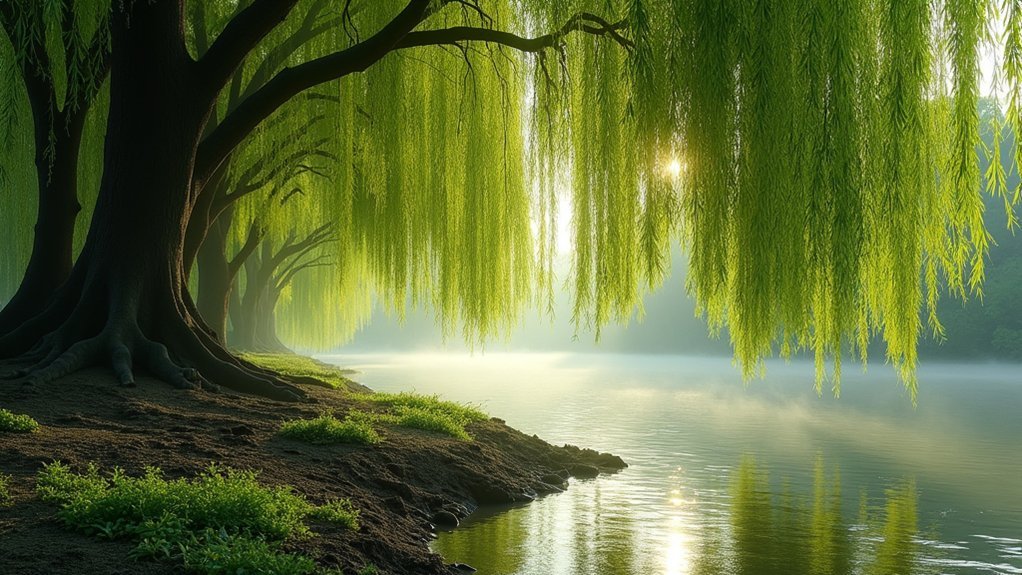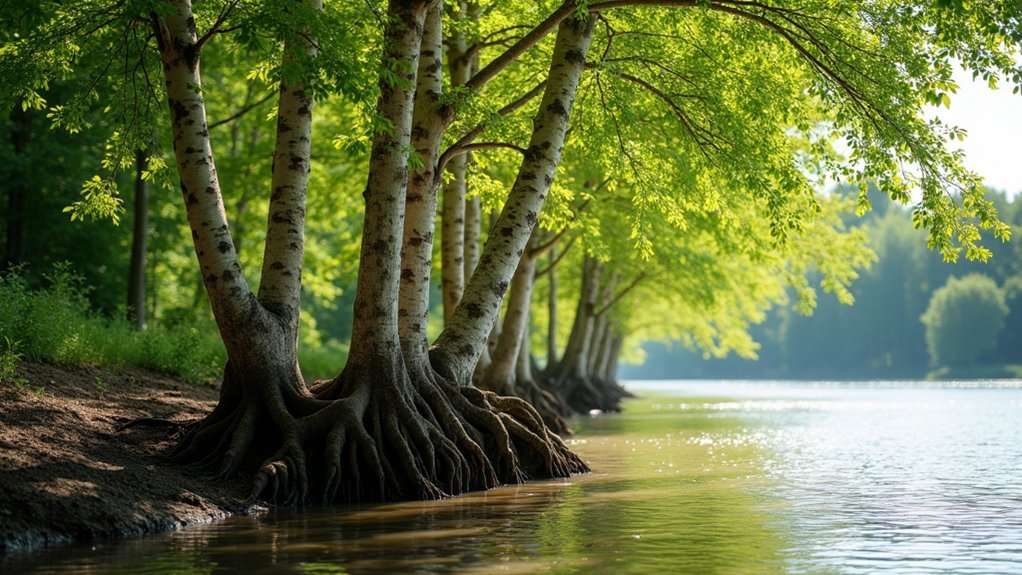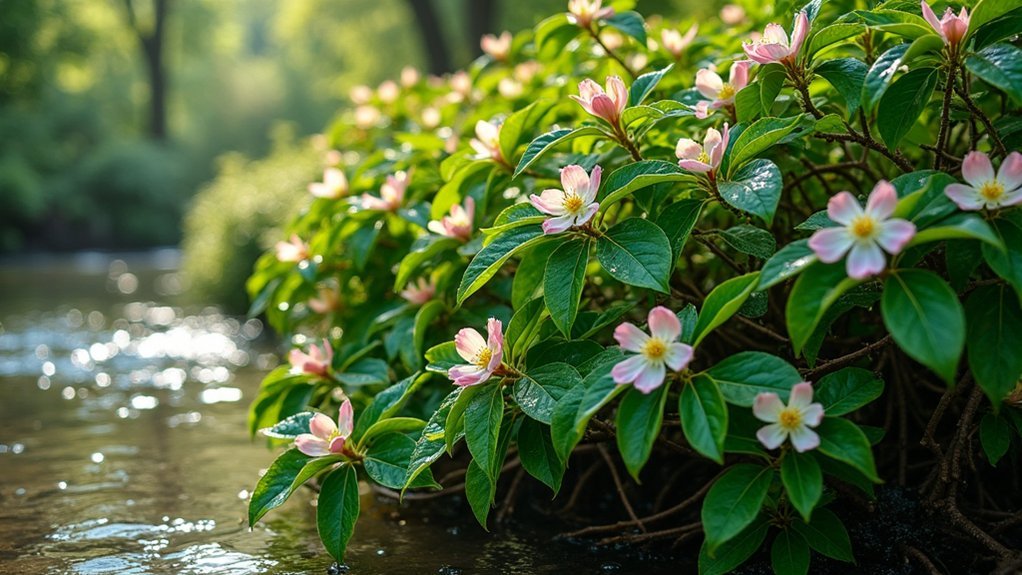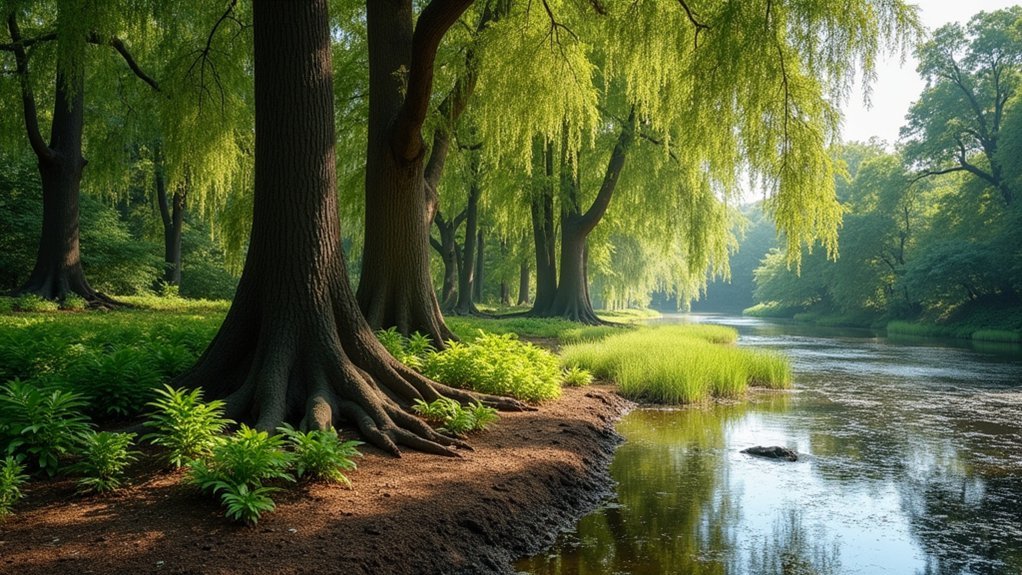For flood-prone areas, create resilient natural boundaries with these seven plants: Willow Trees (particularly Black Willow) offer deep stabilizing roots, while River Birch provides elegant erosion control. Consider hardy Switchgrass for dense barriers and colorful Dogwood Shrubs for wet conditions. Buttonbush attracts wildlife while strengthening soggy soil, Cardinal Flower adds vibrant color to wet borders, and Bald Cypress delivers long-term solutions with its distinctive “knees.” These flood-fighters will transform your vulnerable landscape into a thriving protective barrier.
Willow Trees: Nature’s Flood-Fighting Sentinels

While many plants struggle in waterlogged conditions, willow trees stand as nature’s resilient flood fighters. You’ll find varieties like the Black Willow (Salix nigra) thriving in flood-prone areas where other species fail.
Their deep roots create an extensive underground network that stabilizes soil and prevents erosion along riverbanks and wetlands.
These impressive trees grow rapidly, reaching 30-60 feet, and adapt to both saturated soils and periodic drought.
When you’re planning for flood management, willows offer multiple benefits—they absorb excess water, filter pollutants from groundwater, and enhance soil quality.
Their versatility makes them perfect for restoration projects where you need plants that contribute to biodiversity while providing natural erosion control in challenging environments.
Switchgrass: Resilient Barriers Against Rising Waters
When floodwaters threaten your landscape, switchgrass (Panicum virgatum) stands as a formidable natural barrier worth considering. This hardy herbaceous perennial thrives in moist soil conditions while withstanding extended flooding that would destroy less resilient plants.
Native to North America and adaptable across USDA zones 4-9, switchgrass grows 3-6 feet tall with deep, fibrous root systems that effectively prevent erosion in flood-prone areas. You’ll appreciate how these roots stabilize soil integrity when water levels rise.
Deeply rooted and tenacious, switchgrass anchors vulnerable soils—standing sentinel against rising waters that would wash away lesser plants.
Beyond flood protection, you’re adding seasonal interest to your landscape—switchgrass transforms into stunning yellows and oranges from late summer through winter.
As a bonus, this native plant supports local wildlife, providing both habitat and food sources while creating a beautiful, functional boundary that works with nature’s challenges rather than against them.
River Birch: Elegant Protection for Waterway Edges

River Birch trees offer you an effective solution for flood-prone areas with their extensive, soil-stabilizing root systems that prevent erosion along waterways.
You’ll appreciate the tree’s ornamental peeling bark that provides year-round visual interest even as it works to protect vulnerable landscapes.
Flood-Adapted Root Systems
Along waterway edges where erosion threatens stability, the impressive River Birch stands as nature’s engineer against flood damage.
What makes this tree exceptional is its specialized flood-adapted root systems that thrive in waterlogged conditions where other species fail.
When you plant River Birch along vulnerable banks, you’re deploying a natural defense mechanism. Its extensive root system creates a complex underground network that firmly grips soil particles, preventing them from washing away during high water events.
These roots actively stabilize soil by forming a living mesh that holds riverbanks intact.
Unlike trees with deeper taproots, River Birch develops shallow, widespread roots specifically evolved for flood conditions.
This adaptation allows it to anchor effectively in wet soils while maximizing oxygen uptake—a perfect solution for natural waterway protection.
Ornamental Peeling Bark
Beauty meets function in the River Birch’s distinctive peeling bark, which transforms flood-prone areas into visually striking landscapes.
This native North American deciduous shrub grows to impressive heights of 40-70 feet while developing a deep root system that stabilizes soil and prevents erosion along waterways.
- Cinnamon-colored peeling bark creates year-round visual interest when other landscape elements lie dormant
- Ornamental peeling bark naturally exfoliates in thin, papery layers revealing multiple color variations beneath
- Bark provides valuable habitat for beneficial insects and small wildlife species
- Deep root system filters pollutants before they reach waterways, improving water quality
- Unlike other birch varieties, River Birch resists the destructive bronze birch borer, ensuring your investment thrives for decades
Wildlife Habitat Provider
Ecosystems flourish around River Birch trees, creating vibrant wildlife sanctuaries in flood-prone areas. When you plant this native species, you’re establishing more than just a boundary—you’re creating a wildlife habitat provider that supports diverse local fauna.
Your River Birch provides food through its seeds and foliage, attracting birds that feast on caterpillars living in its branches. Its 40-foot canopy offers nesting sites and protection from predators, while its extensive root system creates microhabitats for ground-dwelling creatures.
For large areas along waterways, River Birch establishes a complete habitat corridor, connecting fragmented landscapes. The tree’s rapid growth means you’ll quickly develop a functioning ecosystem that stabilizes soil while supporting native birds, beneficial insects, and small mammals—all while managing floodwater challenges.
Dogwood Shrubs: Colorful Defenders of Soggy Boundaries

Dogwood shrubs offer you vibrant red stems that create stunning winter boundaries while their extensive root systems excel at stabilizing soggy soil prone to flooding.
You’ll find these moisture-loving varieties thrive in wet conditions where other plants struggle, making them perfect additions to your rain garden or waterway edge.
Their year-round appeal extends beyond practical erosion control as they provide colorful visual interest and valuable habitat for local wildlife throughout changing seasons.
Moisture-Loving Vibrant Varieties
While many plants struggle in waterlogged conditions, dogwood shrubs stand as champions of wet areas, transforming problematic soggy boundaries into vibrant landscape features. These adaptable natives thrive in moist soils while providing multiple seasons of interest for your garden.
- Red-Ozier Dogwood offers stunning winter appeal with bright red stems that pop against snowy landscapes.
- Roughleaf Dogwood’s small white flowers attract butterflies and birds, making it perfect for native gardens.
- Their extensive root systems effectively combat soil erosion along wetland edges and slopes.
- You’ll appreciate their versatility in handling fluctuating moisture levels, from soggy to occasionally dry.
- Their natural suckering habit creates dense thickets that establish living boundaries while supporting local biodiversity.
Consider these moisture-loving varieties for problematic wet areas where other plants fail to thrive.
Root System Benefits
Beneath the surface of these appealing shrubs lies a powerful flood-defense network that transforms vulnerable landscapes. Dogwood shrubs develop extensive root systems that excel at managing excess water, making them ideal defenders for soggy boundaries.
After heavy rain, these roots efficiently absorb runoff while simultaneously anchoring soil along creek edges and flood-prone areas.
The Roughleaf Dogwood’s suckering nature creates dense thickets that provide exceptional soil stabilization, preventing erosion where water flow would otherwise wash away valuable topsoil.
You’ll appreciate how these versatile plants adapt to both saturated and dry conditions, maintaining their protective functions regardless of fluctuating water levels.
Their ability to spread naturally means your investment in a few dogwoods today will develop into a robust natural boundary that grows stronger with each passing season.
Year-Round Boundary Appeal
Beyond their practical flood-control benefits, these resilient shrubs deliver four-season landscape drama that transforms ordinary boundaries into dynamic living fences.
You’ll enjoy constant visual interest when you plant Red-Oiser Dogwood along your soggy property lines. As native plants, they’re perfectly adapted to thrive in zones 2-7 while supporting local wildlife.
- Spring brings delicate clusters of white flowers attracting essential pollinators
- Summer foliage creates dense privacy screens while stabilizing wet soils
- Fall transforms leaves into rich burgundy hues complementing autumn landscapes
- Winter reveals striking red stems that stand out brilliantly against snow
- Year-round appeal includes habitat creation for birds who nest in the protective branches
The Red-Oiser’s versatility makes it an exceptional choice for homeowners seeking both functionality and beauty in flood-prone areas.
Buttonbush: Wildlife-Friendly Flood Plain Stabilizers

Nature’s multitasker, the buttonbush (*Cephalanthus occidentalis*) offers a perfect solution for flood-prone landscapes that need stabilization. This native plant thrives where others fail, creating dense thickets that secure soil while attracting diverse wildlife to your property.
| Feature | Benefit |
|---|---|
| White flowers | Attract bees and butterflies |
| Dense growth | Prevents erosion in floodplains |
| Height (up to 12ft) | Creates natural privacy barrier |
| Berries | Provide food for birds and mammals |
| Adaptability | Tolerates both flooding and drought |
You’ll appreciate buttonbush’s versatility when establishing boundaries in challenging wet areas. Its spherical flower clusters create visual interest while supporting pollinators. This flood-proof shrub requires minimal maintenance once established, making it an efficient choice for naturalizing areas where water fluctuations are common.
Cardinal Flower: Beautiful Bloomers for Wet Border Areas
Brilliance defines the Cardinal Flower (*Lobelia cardinalis*), whose stunning scarlet blooms transform wet garden borders into vibrant wildlife hubs.
You’ll appreciate how these resilient plants adapt to fluctuating water levels while bringing dramatic color to your landscape. Standing 2-4 feet tall, they’re perfect for rain gardens and flood-prone areas where other flowers might fail.
- Attracts hummingbirds with its vibrant red flowers during summer months
- Thrives in consistently moist soils yet tolerates brief flooding and drought
- Grows successfully in partial shade to full sun environments
- Hardy across USDA zones 3-9, making it versatile for most North American gardens
- Creates stunning vertical interest along wet borders where few other flowering plants perform well
Bald Cypress: Long-Term Solutions for Waterlogged Boundaries

While cardinal flowers bring vibrant color to wet garden borders, you’ll find the majestic Bald Cypress offers a more substantial solution for persistently waterlogged areas. This deciduous conifer thrives where other trees fail, tolerating flooding and poor drainage with ease.
Your waterlogged boundaries will benefit from this long-lived species, which can survive over 1,000 years and reach heights of 100 feet. Bald cypress develops distinctive “knees” that rise above water surfaces, stabilizing the tree and aerating its extensive root system in saturated soils.
You’ll appreciate how this tree serves multiple purposes: creating a visual barrier, providing wildlife habitat, and improving ecological balance. Its ability to sequester carbon while managing soggy conditions makes it an ideal investment for flood-prone properties where you need a sustainable, long-term solution.
Frequently Asked Questions
What Plant Is Good for Flooding?
You’ll find that Frogfruit, Big Muhly, Winterberry, Ligularia, and Tropical Sage all handle flooding well. They’ve got adaptable root systems that thrive in wet conditions while still surviving when it dries out.
What Plants Can Withstand a Lot of Water?
You’ll find frogfruit tolerates extended flooding while tropical sage, big muhly, Virginia willow, and winterberry also withstand significant water. These resilient plants manage excess moisture with their specialized root systems and adaptations.
What Plants Are Good for Erosion Control?
For erosion control, you’ll find suckering shrubs like Aronia and deep-rooted prairie natives like Red Switch Grass highly effective. Don’t overlook daylilies with their dense roots. Pair these plants with erosion control blankets for best results.
What Is the Best Shrub for Flooding?
Red-Osier Dogwood is your best flooding shrub. It’s perfect because its dense suckering habit stabilizes soil in wet areas, plus you’ll enjoy those bright red stems during winter months in zones 2-7.
In Summary
You’ll find these seven flood-resistant plants transform vulnerable boundaries into resilient natural barriers. They’re not just practical choices for managing water flow and preventing erosion—they’re beautiful additions to your landscape that support local wildlife. By incorporating these adaptable species into your property borders, you’re creating sustainable solutions that work with nature rather than against it. Your flood-prone areas can become thriving ecological assets.





Leave a Reply